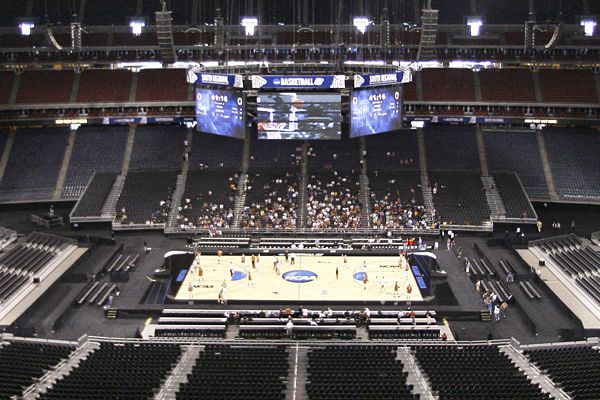Hosting Final Fours in Large Football Domes Makes the Most Sense
Posted by Chris Johnson on September 11th, 2012Chris Johnson is an RTC columnist. He can be reached @ChrisDJohnsonn.
It always seemed slightly awkward that the Final Four, college basketball’s marquee postseason event, is played out in 70,000-seat football arenas across the country, rather than buildings actually designed to house basketball events. Fans spend the season watching their teams compete in basketball arenas across the country, many of which offer unique, quaint environments that are as much a part of the program as the team itself. In world where ticket revenue maximization and logistical considerations are the driving forces behind stadium construction and renovation, it’s these college hoops atmospheres – Hinkle Fieldhouse, Cameron Indoor Stadium, the Palestra – that give the sport a certain level of authenticity. There’s something endearing about the program-specific uniqueness that envelops college arenas, something vaguely intangible the sport simply wouldn’t be the same without. It would only make sense to have college basketball’s national champion determined under the same setting – not only for familiarity reasons, but to preserve college basketball’s amateur feel at the highest levels of competition. At the very least, basketball arenas – if not college structures, then NBA stadiums – offer settings far more tolerable than the large and unseemly football dome monoliths that have been adopted for college basketball’s three most important games (two national semifinals, and the championship game).

Large Domes like Ford Field have exclusively hosted the Final Four since 1997. That’s likely to continue for the foreseeable future (Photo credit: David J. Phillip/AP Photo).
But its no secret why the NCAA has opted for these awkward hosting sites. For one, bigger stadiums means more seats, which means more ticket revenues. If fans are willing to fill a reasonable proportion of a football dome’s enormous seating capacity in spite of several unattractive features – poor viewing angles, increased ticket prices – then it’s hard to argue with keeping the games in these large structures. From a revenue perspective, it just makes sense. But there are a host of other concerns to consider: space for increasing media contingents, infrastructural necessities (restaurants, hotels, parking, etc.), the conventions and parties and fan events that accompany major sporting events like the Final Four. Large football domes, despite all their aesthetic shortcomings, are better-equipped to handle the event in this regard. In short, football arenas in large cities offer the optimal blend of seating accommodations and resourceful necessities for hosting a sporting spectacle as massive and as important as the Final Four.









































